Analysis of Outward FDI Benefits for Developing Nations: Case Study
VerifiedAdded on 2023/01/17
|15
|4320
|80
Case Study
AI Summary
This case study analyzes the benefits that developing nations derive from outward Foreign Direct Investment (FDI). It explores the application of FDI theories, specifically capital market theory and location-based approaches, to understand how outward FDI contributes to economic growth, technology transfer, and access to resources. The case study examines the differences in costs and benefits between South-South and South-North outward investment, emphasizing the importance of government policies in maximizing the advantages of outward FDI. The individual essay further delves into the concepts of FDI, its different types, and its role in the global economy, providing a comprehensive overview of the topic.
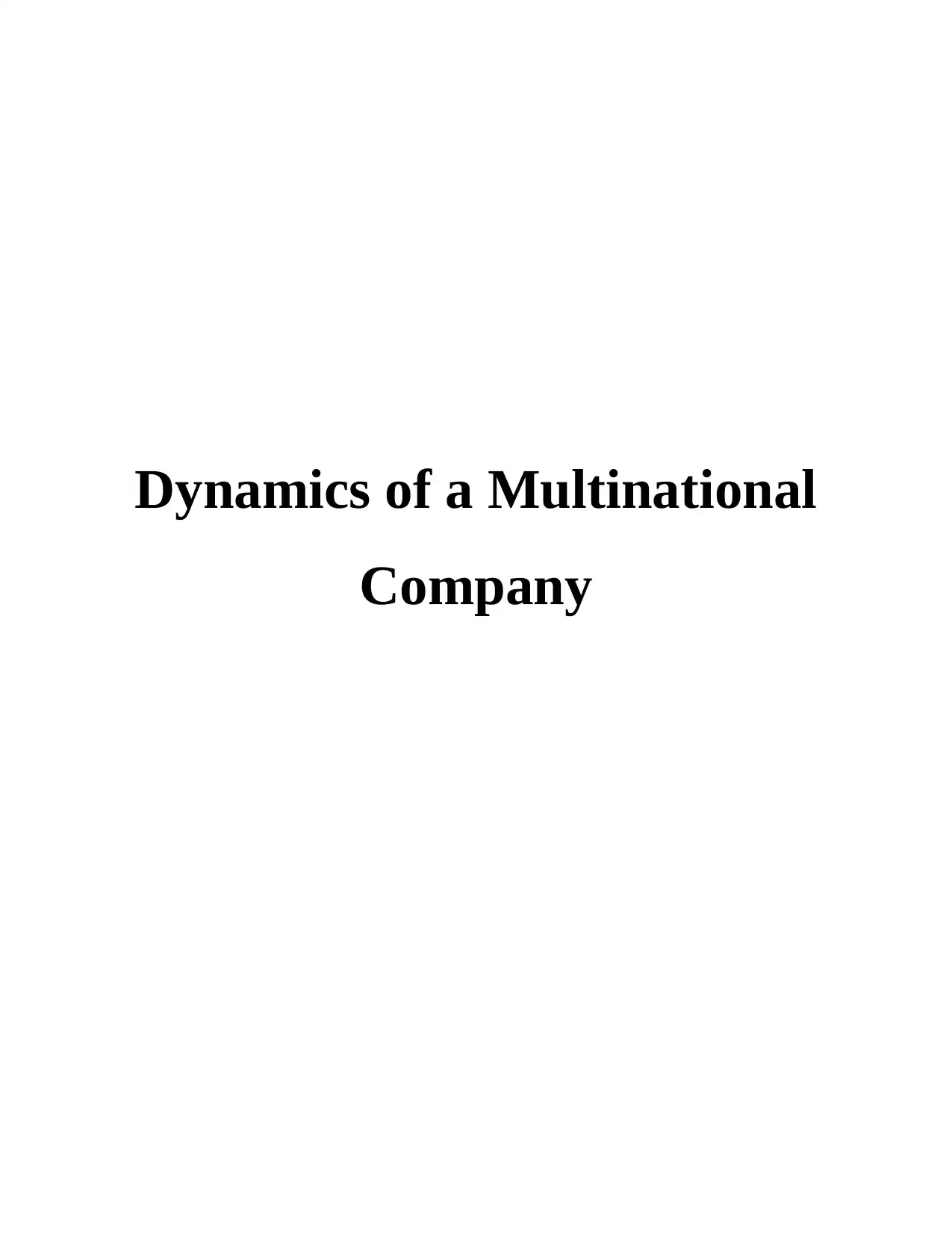
Dynamics of a Multinational
Company
Company
Paraphrase This Document
Need a fresh take? Get an instant paraphrase of this document with our AI Paraphraser
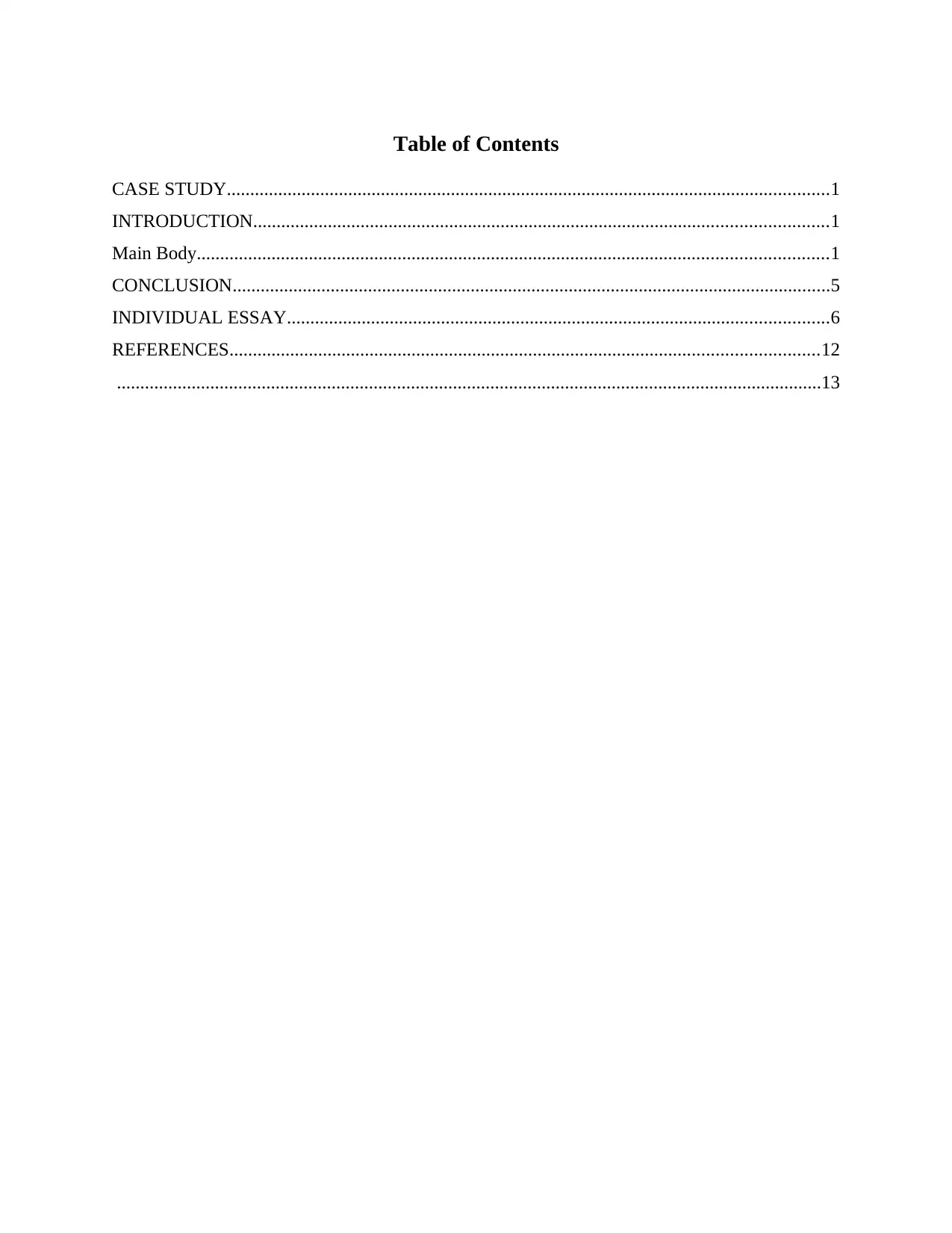
Table of Contents
CASE STUDY.................................................................................................................................1
INTRODUCTION...........................................................................................................................1
Main Body.......................................................................................................................................1
CONCLUSION................................................................................................................................5
INDIVIDUAL ESSAY....................................................................................................................6
REFERENCES..............................................................................................................................12
.......................................................................................................................................................13
CASE STUDY.................................................................................................................................1
INTRODUCTION...........................................................................................................................1
Main Body.......................................................................................................................................1
CONCLUSION................................................................................................................................5
INDIVIDUAL ESSAY....................................................................................................................6
REFERENCES..............................................................................................................................12
.......................................................................................................................................................13
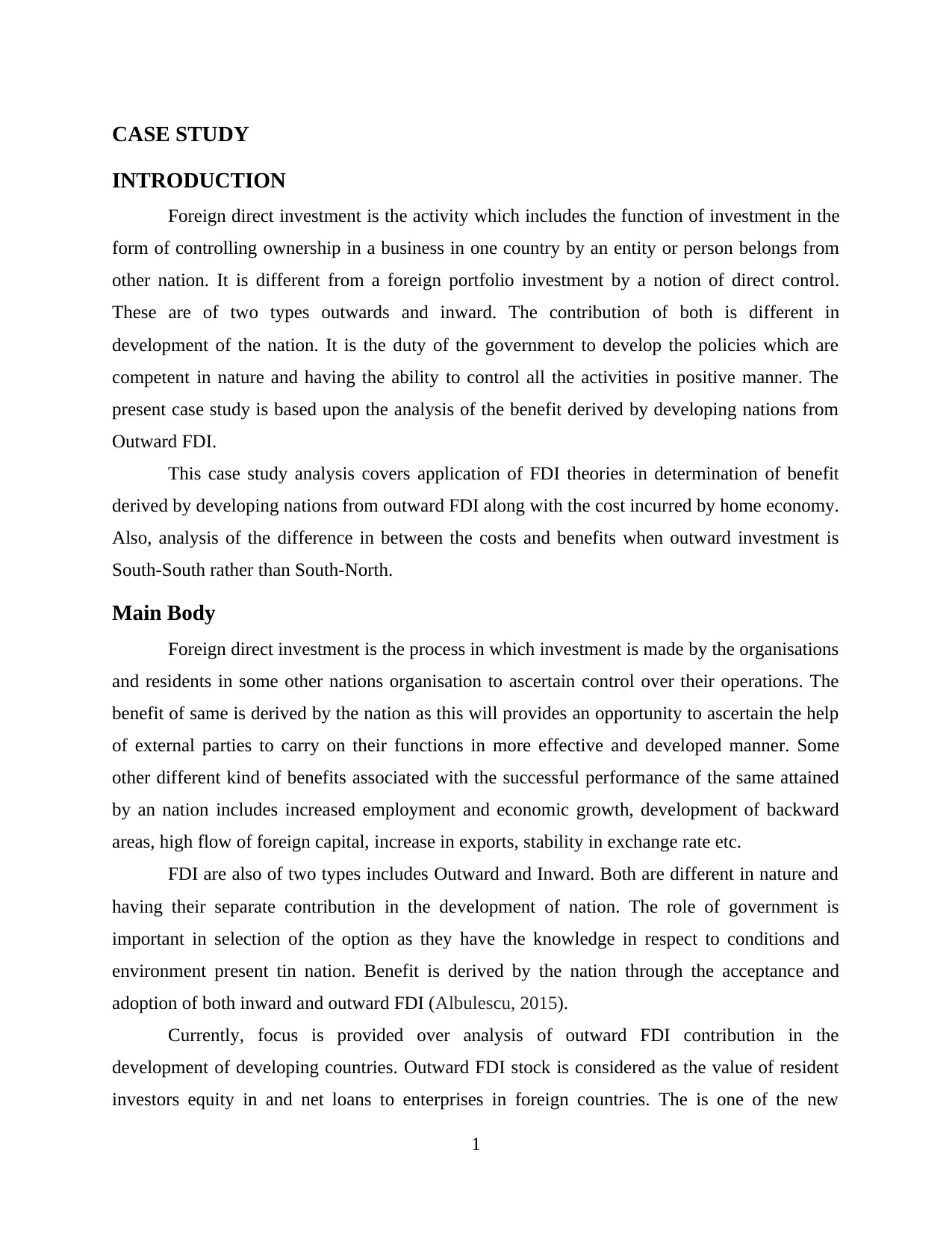
CASE STUDY
INTRODUCTION
Foreign direct investment is the activity which includes the function of investment in the
form of controlling ownership in a business in one country by an entity or person belongs from
other nation. It is different from a foreign portfolio investment by a notion of direct control.
These are of two types outwards and inward. The contribution of both is different in
development of the nation. It is the duty of the government to develop the policies which are
competent in nature and having the ability to control all the activities in positive manner. The
present case study is based upon the analysis of the benefit derived by developing nations from
Outward FDI.
This case study analysis covers application of FDI theories in determination of benefit
derived by developing nations from outward FDI along with the cost incurred by home economy.
Also, analysis of the difference in between the costs and benefits when outward investment is
South-South rather than South-North.
Main Body
Foreign direct investment is the process in which investment is made by the organisations
and residents in some other nations organisation to ascertain control over their operations. The
benefit of same is derived by the nation as this will provides an opportunity to ascertain the help
of external parties to carry on their functions in more effective and developed manner. Some
other different kind of benefits associated with the successful performance of the same attained
by an nation includes increased employment and economic growth, development of backward
areas, high flow of foreign capital, increase in exports, stability in exchange rate etc.
FDI are also of two types includes Outward and Inward. Both are different in nature and
having their separate contribution in the development of nation. The role of government is
important in selection of the option as they have the knowledge in respect to conditions and
environment present tin nation. Benefit is derived by the nation through the acceptance and
adoption of both inward and outward FDI (Albulescu, 2015).
Currently, focus is provided over analysis of outward FDI contribution in the
development of developing countries. Outward FDI stock is considered as the value of resident
investors equity in and net loans to enterprises in foreign countries. The is one of the new
1
INTRODUCTION
Foreign direct investment is the activity which includes the function of investment in the
form of controlling ownership in a business in one country by an entity or person belongs from
other nation. It is different from a foreign portfolio investment by a notion of direct control.
These are of two types outwards and inward. The contribution of both is different in
development of the nation. It is the duty of the government to develop the policies which are
competent in nature and having the ability to control all the activities in positive manner. The
present case study is based upon the analysis of the benefit derived by developing nations from
Outward FDI.
This case study analysis covers application of FDI theories in determination of benefit
derived by developing nations from outward FDI along with the cost incurred by home economy.
Also, analysis of the difference in between the costs and benefits when outward investment is
South-South rather than South-North.
Main Body
Foreign direct investment is the process in which investment is made by the organisations
and residents in some other nations organisation to ascertain control over their operations. The
benefit of same is derived by the nation as this will provides an opportunity to ascertain the help
of external parties to carry on their functions in more effective and developed manner. Some
other different kind of benefits associated with the successful performance of the same attained
by an nation includes increased employment and economic growth, development of backward
areas, high flow of foreign capital, increase in exports, stability in exchange rate etc.
FDI are also of two types includes Outward and Inward. Both are different in nature and
having their separate contribution in the development of nation. The role of government is
important in selection of the option as they have the knowledge in respect to conditions and
environment present tin nation. Benefit is derived by the nation through the acceptance and
adoption of both inward and outward FDI (Albulescu, 2015).
Currently, focus is provided over analysis of outward FDI contribution in the
development of developing countries. Outward FDI stock is considered as the value of resident
investors equity in and net loans to enterprises in foreign countries. The is one of the new
1
⊘ This is a preview!⊘
Do you want full access?
Subscribe today to unlock all pages.

Trusted by 1+ million students worldwide
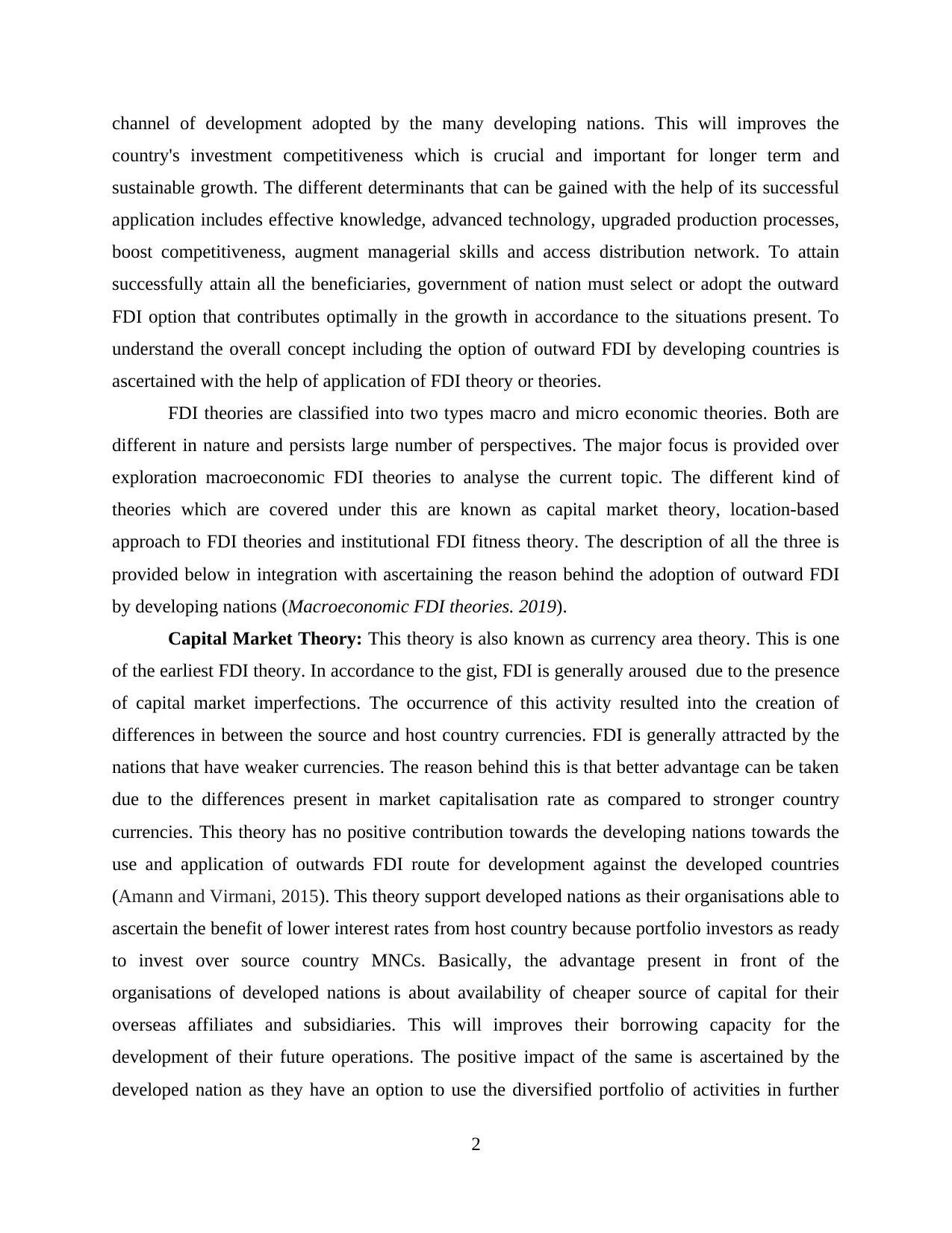
channel of development adopted by the many developing nations. This will improves the
country's investment competitiveness which is crucial and important for longer term and
sustainable growth. The different determinants that can be gained with the help of its successful
application includes effective knowledge, advanced technology, upgraded production processes,
boost competitiveness, augment managerial skills and access distribution network. To attain
successfully attain all the beneficiaries, government of nation must select or adopt the outward
FDI option that contributes optimally in the growth in accordance to the situations present. To
understand the overall concept including the option of outward FDI by developing countries is
ascertained with the help of application of FDI theory or theories.
FDI theories are classified into two types macro and micro economic theories. Both are
different in nature and persists large number of perspectives. The major focus is provided over
exploration macroeconomic FDI theories to analyse the current topic. The different kind of
theories which are covered under this are known as capital market theory, location-based
approach to FDI theories and institutional FDI fitness theory. The description of all the three is
provided below in integration with ascertaining the reason behind the adoption of outward FDI
by developing nations (Macroeconomic FDI theories. 2019).
Capital Market Theory: This theory is also known as currency area theory. This is one
of the earliest FDI theory. In accordance to the gist, FDI is generally aroused due to the presence
of capital market imperfections. The occurrence of this activity resulted into the creation of
differences in between the source and host country currencies. FDI is generally attracted by the
nations that have weaker currencies. The reason behind this is that better advantage can be taken
due to the differences present in market capitalisation rate as compared to stronger country
currencies. This theory has no positive contribution towards the developing nations towards the
use and application of outwards FDI route for development against the developed countries
(Amann and Virmani, 2015). This theory support developed nations as their organisations able to
ascertain the benefit of lower interest rates from host country because portfolio investors as ready
to invest over source country MNCs. Basically, the advantage present in front of the
organisations of developed nations is about availability of cheaper source of capital for their
overseas affiliates and subsidiaries. This will improves their borrowing capacity for the
development of their future operations. The positive impact of the same is ascertained by the
developed nation as they have an option to use the diversified portfolio of activities in further
2
country's investment competitiveness which is crucial and important for longer term and
sustainable growth. The different determinants that can be gained with the help of its successful
application includes effective knowledge, advanced technology, upgraded production processes,
boost competitiveness, augment managerial skills and access distribution network. To attain
successfully attain all the beneficiaries, government of nation must select or adopt the outward
FDI option that contributes optimally in the growth in accordance to the situations present. To
understand the overall concept including the option of outward FDI by developing countries is
ascertained with the help of application of FDI theory or theories.
FDI theories are classified into two types macro and micro economic theories. Both are
different in nature and persists large number of perspectives. The major focus is provided over
exploration macroeconomic FDI theories to analyse the current topic. The different kind of
theories which are covered under this are known as capital market theory, location-based
approach to FDI theories and institutional FDI fitness theory. The description of all the three is
provided below in integration with ascertaining the reason behind the adoption of outward FDI
by developing nations (Macroeconomic FDI theories. 2019).
Capital Market Theory: This theory is also known as currency area theory. This is one
of the earliest FDI theory. In accordance to the gist, FDI is generally aroused due to the presence
of capital market imperfections. The occurrence of this activity resulted into the creation of
differences in between the source and host country currencies. FDI is generally attracted by the
nations that have weaker currencies. The reason behind this is that better advantage can be taken
due to the differences present in market capitalisation rate as compared to stronger country
currencies. This theory has no positive contribution towards the developing nations towards the
use and application of outwards FDI route for development against the developed countries
(Amann and Virmani, 2015). This theory support developed nations as their organisations able to
ascertain the benefit of lower interest rates from host country because portfolio investors as ready
to invest over source country MNCs. Basically, the advantage present in front of the
organisations of developed nations is about availability of cheaper source of capital for their
overseas affiliates and subsidiaries. This will improves their borrowing capacity for the
development of their future operations. The positive impact of the same is ascertained by the
developed nation as they have an option to use the diversified portfolio of activities in further
2
Paraphrase This Document
Need a fresh take? Get an instant paraphrase of this document with our AI Paraphraser
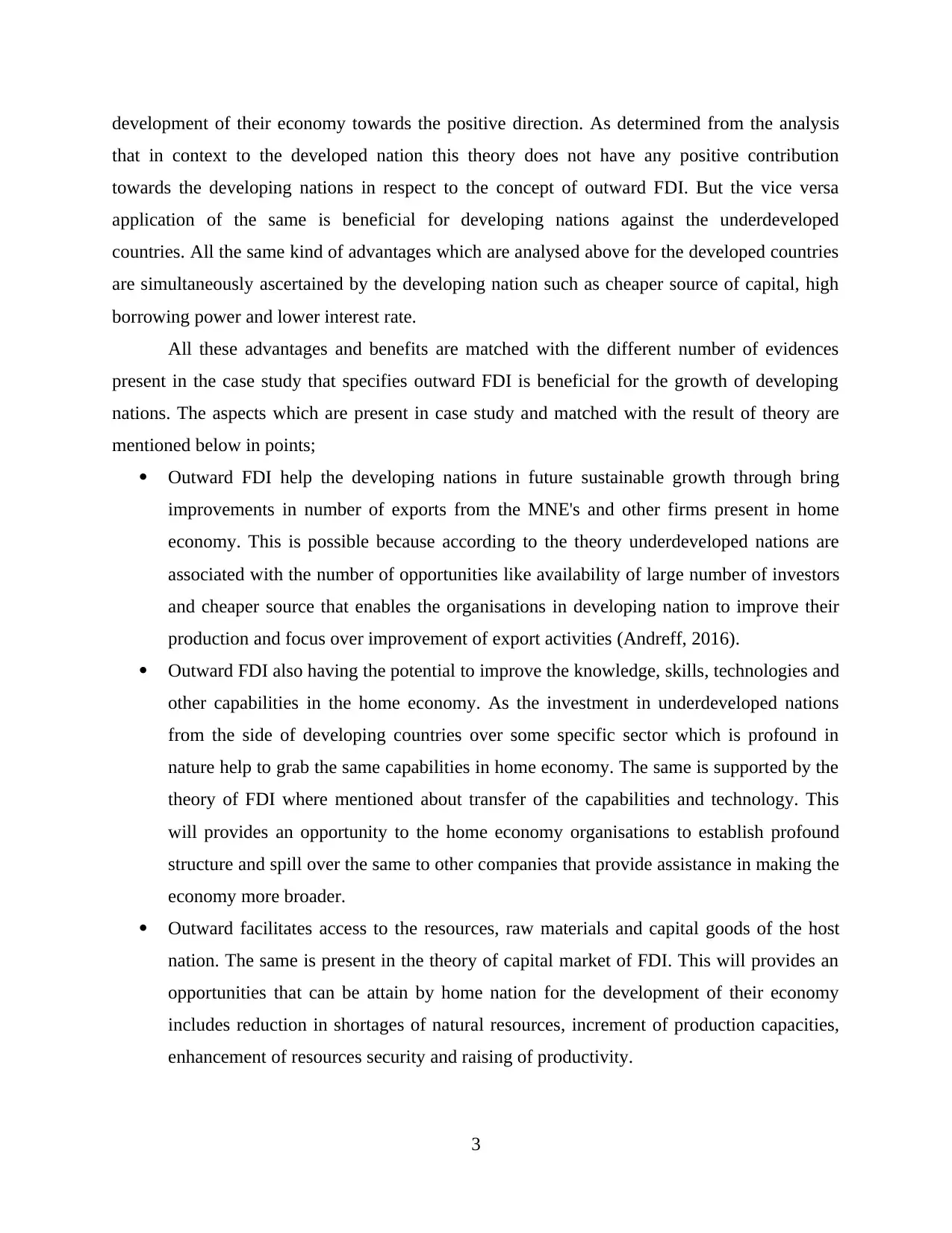
development of their economy towards the positive direction. As determined from the analysis
that in context to the developed nation this theory does not have any positive contribution
towards the developing nations in respect to the concept of outward FDI. But the vice versa
application of the same is beneficial for developing nations against the underdeveloped
countries. All the same kind of advantages which are analysed above for the developed countries
are simultaneously ascertained by the developing nation such as cheaper source of capital, high
borrowing power and lower interest rate.
All these advantages and benefits are matched with the different number of evidences
present in the case study that specifies outward FDI is beneficial for the growth of developing
nations. The aspects which are present in case study and matched with the result of theory are
mentioned below in points;
Outward FDI help the developing nations in future sustainable growth through bring
improvements in number of exports from the MNE's and other firms present in home
economy. This is possible because according to the theory underdeveloped nations are
associated with the number of opportunities like availability of large number of investors
and cheaper source that enables the organisations in developing nation to improve their
production and focus over improvement of export activities (Andreff, 2016).
Outward FDI also having the potential to improve the knowledge, skills, technologies and
other capabilities in the home economy. As the investment in underdeveloped nations
from the side of developing countries over some specific sector which is profound in
nature help to grab the same capabilities in home economy. The same is supported by the
theory of FDI where mentioned about transfer of the capabilities and technology. This
will provides an opportunity to the home economy organisations to establish profound
structure and spill over the same to other companies that provide assistance in making the
economy more broader.
Outward facilitates access to the resources, raw materials and capital goods of the host
nation. The same is present in the theory of capital market of FDI. This will provides an
opportunities that can be attain by home nation for the development of their economy
includes reduction in shortages of natural resources, increment of production capacities,
enhancement of resources security and raising of productivity.
3
that in context to the developed nation this theory does not have any positive contribution
towards the developing nations in respect to the concept of outward FDI. But the vice versa
application of the same is beneficial for developing nations against the underdeveloped
countries. All the same kind of advantages which are analysed above for the developed countries
are simultaneously ascertained by the developing nation such as cheaper source of capital, high
borrowing power and lower interest rate.
All these advantages and benefits are matched with the different number of evidences
present in the case study that specifies outward FDI is beneficial for the growth of developing
nations. The aspects which are present in case study and matched with the result of theory are
mentioned below in points;
Outward FDI help the developing nations in future sustainable growth through bring
improvements in number of exports from the MNE's and other firms present in home
economy. This is possible because according to the theory underdeveloped nations are
associated with the number of opportunities like availability of large number of investors
and cheaper source that enables the organisations in developing nation to improve their
production and focus over improvement of export activities (Andreff, 2016).
Outward FDI also having the potential to improve the knowledge, skills, technologies and
other capabilities in the home economy. As the investment in underdeveloped nations
from the side of developing countries over some specific sector which is profound in
nature help to grab the same capabilities in home economy. The same is supported by the
theory of FDI where mentioned about transfer of the capabilities and technology. This
will provides an opportunity to the home economy organisations to establish profound
structure and spill over the same to other companies that provide assistance in making the
economy more broader.
Outward facilitates access to the resources, raw materials and capital goods of the host
nation. The same is present in the theory of capital market of FDI. This will provides an
opportunities that can be attain by home nation for the development of their economy
includes reduction in shortages of natural resources, increment of production capacities,
enhancement of resources security and raising of productivity.
3
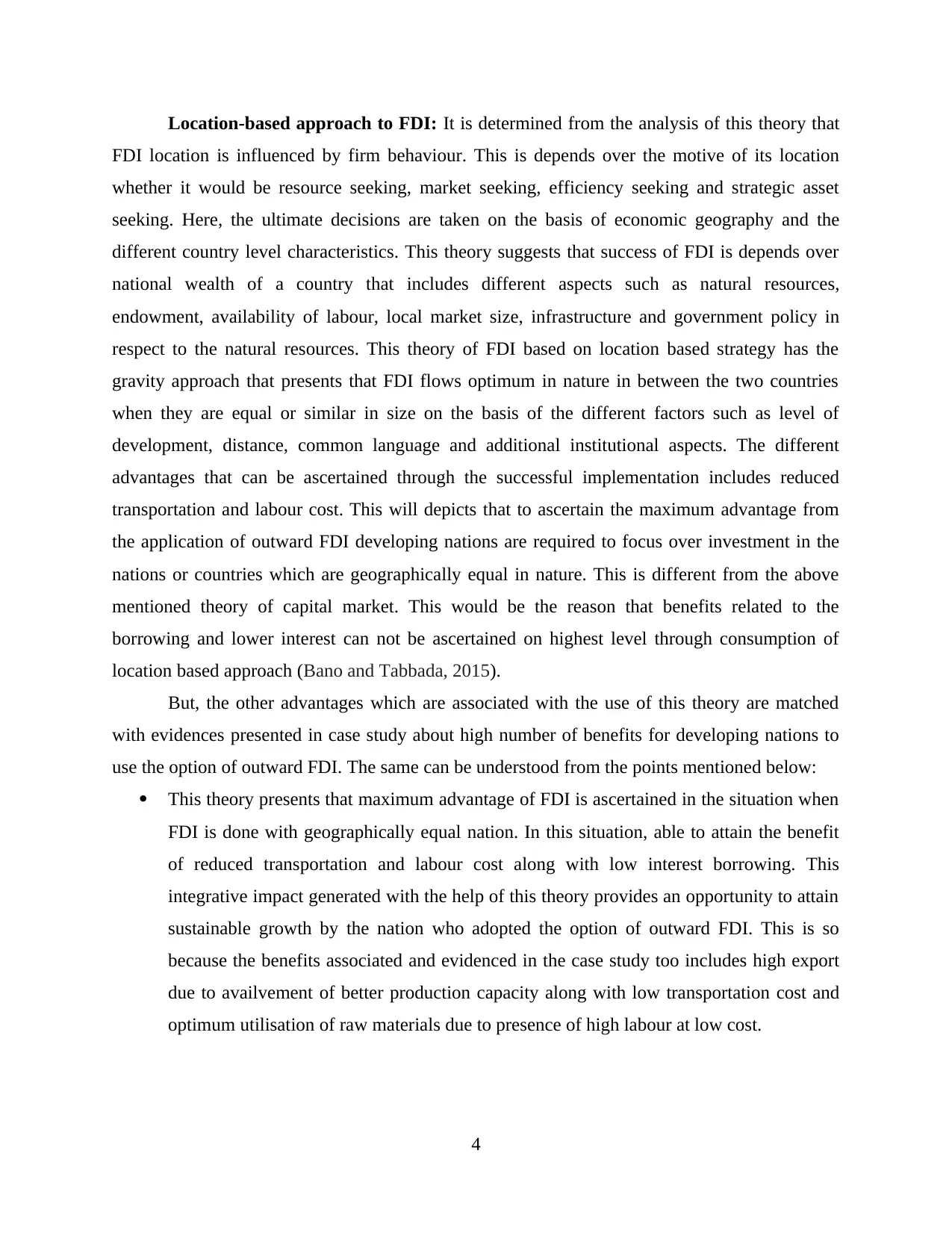
Location-based approach to FDI: It is determined from the analysis of this theory that
FDI location is influenced by firm behaviour. This is depends over the motive of its location
whether it would be resource seeking, market seeking, efficiency seeking and strategic asset
seeking. Here, the ultimate decisions are taken on the basis of economic geography and the
different country level characteristics. This theory suggests that success of FDI is depends over
national wealth of a country that includes different aspects such as natural resources,
endowment, availability of labour, local market size, infrastructure and government policy in
respect to the natural resources. This theory of FDI based on location based strategy has the
gravity approach that presents that FDI flows optimum in nature in between the two countries
when they are equal or similar in size on the basis of the different factors such as level of
development, distance, common language and additional institutional aspects. The different
advantages that can be ascertained through the successful implementation includes reduced
transportation and labour cost. This will depicts that to ascertain the maximum advantage from
the application of outward FDI developing nations are required to focus over investment in the
nations or countries which are geographically equal in nature. This is different from the above
mentioned theory of capital market. This would be the reason that benefits related to the
borrowing and lower interest can not be ascertained on highest level through consumption of
location based approach (Bano and Tabbada, 2015).
But, the other advantages which are associated with the use of this theory are matched
with evidences presented in case study about high number of benefits for developing nations to
use the option of outward FDI. The same can be understood from the points mentioned below:
This theory presents that maximum advantage of FDI is ascertained in the situation when
FDI is done with geographically equal nation. In this situation, able to attain the benefit
of reduced transportation and labour cost along with low interest borrowing. This
integrative impact generated with the help of this theory provides an opportunity to attain
sustainable growth by the nation who adopted the option of outward FDI. This is so
because the benefits associated and evidenced in the case study too includes high export
due to availvement of better production capacity along with low transportation cost and
optimum utilisation of raw materials due to presence of high labour at low cost.
4
FDI location is influenced by firm behaviour. This is depends over the motive of its location
whether it would be resource seeking, market seeking, efficiency seeking and strategic asset
seeking. Here, the ultimate decisions are taken on the basis of economic geography and the
different country level characteristics. This theory suggests that success of FDI is depends over
national wealth of a country that includes different aspects such as natural resources,
endowment, availability of labour, local market size, infrastructure and government policy in
respect to the natural resources. This theory of FDI based on location based strategy has the
gravity approach that presents that FDI flows optimum in nature in between the two countries
when they are equal or similar in size on the basis of the different factors such as level of
development, distance, common language and additional institutional aspects. The different
advantages that can be ascertained through the successful implementation includes reduced
transportation and labour cost. This will depicts that to ascertain the maximum advantage from
the application of outward FDI developing nations are required to focus over investment in the
nations or countries which are geographically equal in nature. This is different from the above
mentioned theory of capital market. This would be the reason that benefits related to the
borrowing and lower interest can not be ascertained on highest level through consumption of
location based approach (Bano and Tabbada, 2015).
But, the other advantages which are associated with the use of this theory are matched
with evidences presented in case study about high number of benefits for developing nations to
use the option of outward FDI. The same can be understood from the points mentioned below:
This theory presents that maximum advantage of FDI is ascertained in the situation when
FDI is done with geographically equal nation. In this situation, able to attain the benefit
of reduced transportation and labour cost along with low interest borrowing. This
integrative impact generated with the help of this theory provides an opportunity to attain
sustainable growth by the nation who adopted the option of outward FDI. This is so
because the benefits associated and evidenced in the case study too includes high export
due to availvement of better production capacity along with low transportation cost and
optimum utilisation of raw materials due to presence of high labour at low cost.
4
⊘ This is a preview!⊘
Do you want full access?
Subscribe today to unlock all pages.

Trusted by 1+ million students worldwide
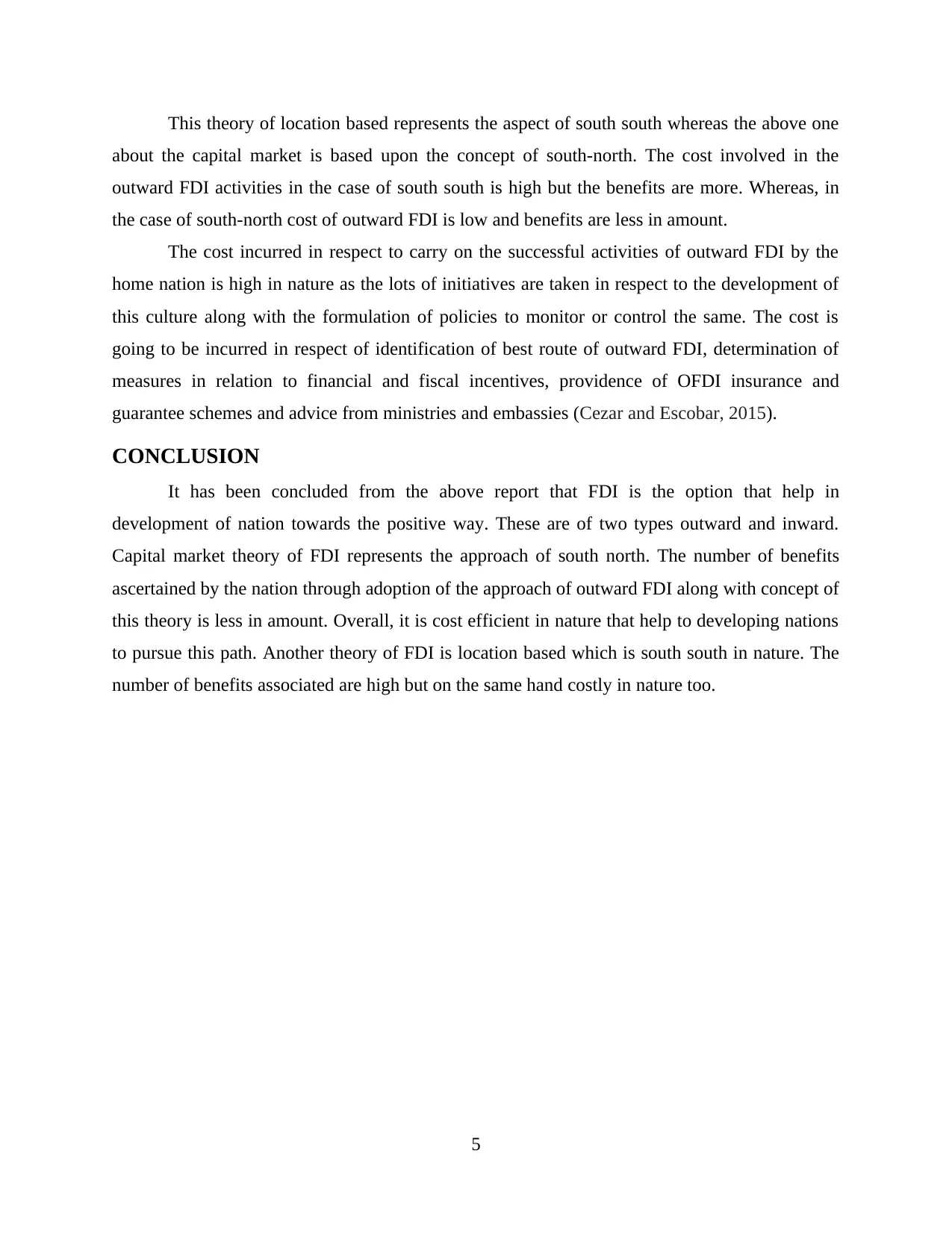
This theory of location based represents the aspect of south south whereas the above one
about the capital market is based upon the concept of south-north. The cost involved in the
outward FDI activities in the case of south south is high but the benefits are more. Whereas, in
the case of south-north cost of outward FDI is low and benefits are less in amount.
The cost incurred in respect to carry on the successful activities of outward FDI by the
home nation is high in nature as the lots of initiatives are taken in respect to the development of
this culture along with the formulation of policies to monitor or control the same. The cost is
going to be incurred in respect of identification of best route of outward FDI, determination of
measures in relation to financial and fiscal incentives, providence of OFDI insurance and
guarantee schemes and advice from ministries and embassies (Cezar and Escobar, 2015).
CONCLUSION
It has been concluded from the above report that FDI is the option that help in
development of nation towards the positive way. These are of two types outward and inward.
Capital market theory of FDI represents the approach of south north. The number of benefits
ascertained by the nation through adoption of the approach of outward FDI along with concept of
this theory is less in amount. Overall, it is cost efficient in nature that help to developing nations
to pursue this path. Another theory of FDI is location based which is south south in nature. The
number of benefits associated are high but on the same hand costly in nature too.
5
about the capital market is based upon the concept of south-north. The cost involved in the
outward FDI activities in the case of south south is high but the benefits are more. Whereas, in
the case of south-north cost of outward FDI is low and benefits are less in amount.
The cost incurred in respect to carry on the successful activities of outward FDI by the
home nation is high in nature as the lots of initiatives are taken in respect to the development of
this culture along with the formulation of policies to monitor or control the same. The cost is
going to be incurred in respect of identification of best route of outward FDI, determination of
measures in relation to financial and fiscal incentives, providence of OFDI insurance and
guarantee schemes and advice from ministries and embassies (Cezar and Escobar, 2015).
CONCLUSION
It has been concluded from the above report that FDI is the option that help in
development of nation towards the positive way. These are of two types outward and inward.
Capital market theory of FDI represents the approach of south north. The number of benefits
ascertained by the nation through adoption of the approach of outward FDI along with concept of
this theory is less in amount. Overall, it is cost efficient in nature that help to developing nations
to pursue this path. Another theory of FDI is location based which is south south in nature. The
number of benefits associated are high but on the same hand costly in nature too.
5
Paraphrase This Document
Need a fresh take? Get an instant paraphrase of this document with our AI Paraphraser
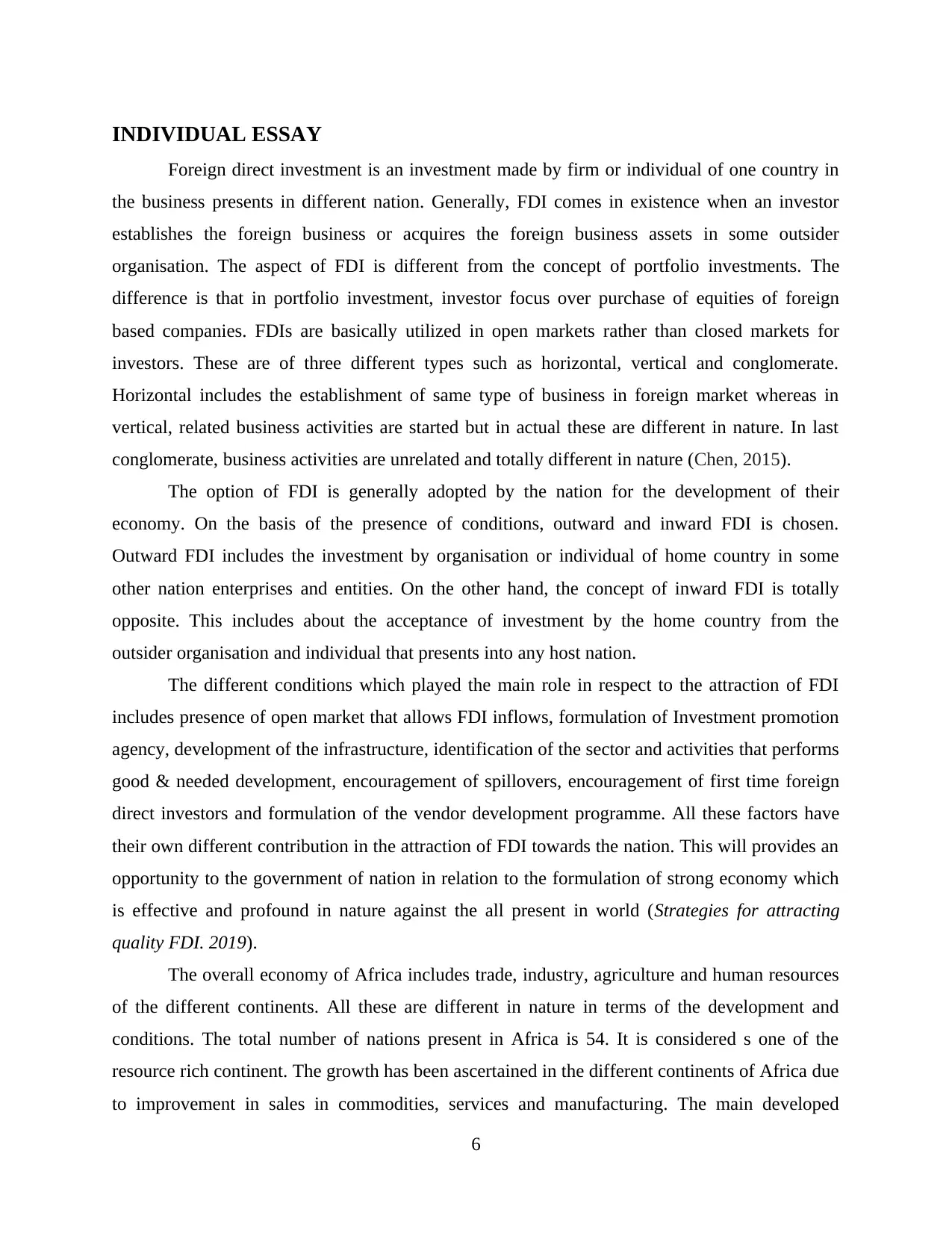
INDIVIDUAL ESSAY
Foreign direct investment is an investment made by firm or individual of one country in
the business presents in different nation. Generally, FDI comes in existence when an investor
establishes the foreign business or acquires the foreign business assets in some outsider
organisation. The aspect of FDI is different from the concept of portfolio investments. The
difference is that in portfolio investment, investor focus over purchase of equities of foreign
based companies. FDIs are basically utilized in open markets rather than closed markets for
investors. These are of three different types such as horizontal, vertical and conglomerate.
Horizontal includes the establishment of same type of business in foreign market whereas in
vertical, related business activities are started but in actual these are different in nature. In last
conglomerate, business activities are unrelated and totally different in nature (Chen, 2015).
The option of FDI is generally adopted by the nation for the development of their
economy. On the basis of the presence of conditions, outward and inward FDI is chosen.
Outward FDI includes the investment by organisation or individual of home country in some
other nation enterprises and entities. On the other hand, the concept of inward FDI is totally
opposite. This includes about the acceptance of investment by the home country from the
outsider organisation and individual that presents into any host nation.
The different conditions which played the main role in respect to the attraction of FDI
includes presence of open market that allows FDI inflows, formulation of Investment promotion
agency, development of the infrastructure, identification of the sector and activities that performs
good & needed development, encouragement of spillovers, encouragement of first time foreign
direct investors and formulation of the vendor development programme. All these factors have
their own different contribution in the attraction of FDI towards the nation. This will provides an
opportunity to the government of nation in relation to the formulation of strong economy which
is effective and profound in nature against the all present in world (Strategies for attracting
quality FDI. 2019).
The overall economy of Africa includes trade, industry, agriculture and human resources
of the different continents. All these are different in nature in terms of the development and
conditions. The total number of nations present in Africa is 54. It is considered s one of the
resource rich continent. The growth has been ascertained in the different continents of Africa due
to improvement in sales in commodities, services and manufacturing. The main developed
6
Foreign direct investment is an investment made by firm or individual of one country in
the business presents in different nation. Generally, FDI comes in existence when an investor
establishes the foreign business or acquires the foreign business assets in some outsider
organisation. The aspect of FDI is different from the concept of portfolio investments. The
difference is that in portfolio investment, investor focus over purchase of equities of foreign
based companies. FDIs are basically utilized in open markets rather than closed markets for
investors. These are of three different types such as horizontal, vertical and conglomerate.
Horizontal includes the establishment of same type of business in foreign market whereas in
vertical, related business activities are started but in actual these are different in nature. In last
conglomerate, business activities are unrelated and totally different in nature (Chen, 2015).
The option of FDI is generally adopted by the nation for the development of their
economy. On the basis of the presence of conditions, outward and inward FDI is chosen.
Outward FDI includes the investment by organisation or individual of home country in some
other nation enterprises and entities. On the other hand, the concept of inward FDI is totally
opposite. This includes about the acceptance of investment by the home country from the
outsider organisation and individual that presents into any host nation.
The different conditions which played the main role in respect to the attraction of FDI
includes presence of open market that allows FDI inflows, formulation of Investment promotion
agency, development of the infrastructure, identification of the sector and activities that performs
good & needed development, encouragement of spillovers, encouragement of first time foreign
direct investors and formulation of the vendor development programme. All these factors have
their own different contribution in the attraction of FDI towards the nation. This will provides an
opportunity to the government of nation in relation to the formulation of strong economy which
is effective and profound in nature against the all present in world (Strategies for attracting
quality FDI. 2019).
The overall economy of Africa includes trade, industry, agriculture and human resources
of the different continents. All these are different in nature in terms of the development and
conditions. The total number of nations present in Africa is 54. It is considered s one of the
resource rich continent. The growth has been ascertained in the different continents of Africa due
to improvement in sales in commodities, services and manufacturing. The main developed
6
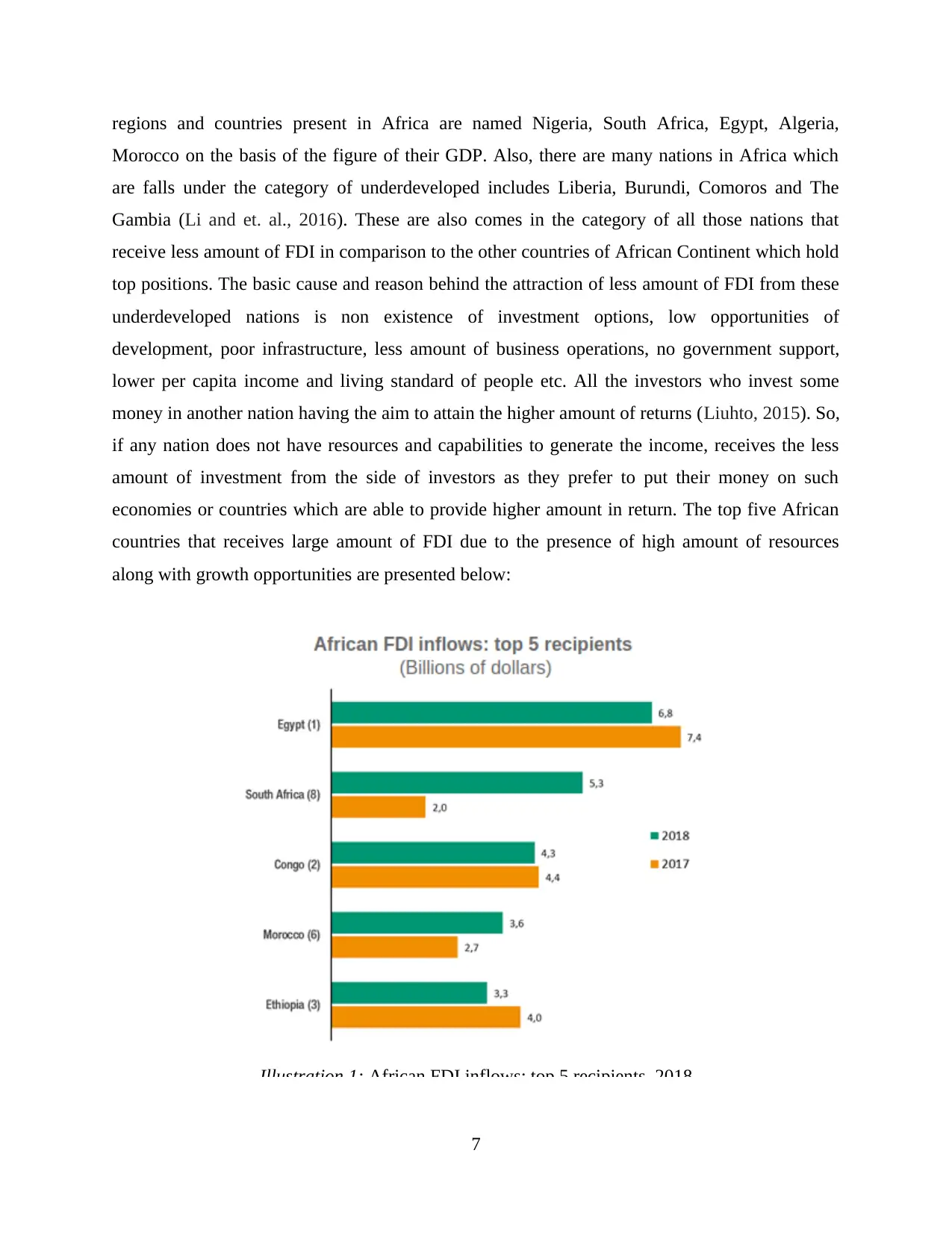
regions and countries present in Africa are named Nigeria, South Africa, Egypt, Algeria,
Morocco on the basis of the figure of their GDP. Also, there are many nations in Africa which
are falls under the category of underdeveloped includes Liberia, Burundi, Comoros and The
Gambia (Li and et. al., 2016). These are also comes in the category of all those nations that
receive less amount of FDI in comparison to the other countries of African Continent which hold
top positions. The basic cause and reason behind the attraction of less amount of FDI from these
underdeveloped nations is non existence of investment options, low opportunities of
development, poor infrastructure, less amount of business operations, no government support,
lower per capita income and living standard of people etc. All the investors who invest some
money in another nation having the aim to attain the higher amount of returns (Liuhto, 2015). So,
if any nation does not have resources and capabilities to generate the income, receives the less
amount of investment from the side of investors as they prefer to put their money on such
economies or countries which are able to provide higher amount in return. The top five African
countries that receives large amount of FDI due to the presence of high amount of resources
along with growth opportunities are presented below:
7
Illustration 1: African FDI inflows: top 5 recipients, 2018
Morocco on the basis of the figure of their GDP. Also, there are many nations in Africa which
are falls under the category of underdeveloped includes Liberia, Burundi, Comoros and The
Gambia (Li and et. al., 2016). These are also comes in the category of all those nations that
receive less amount of FDI in comparison to the other countries of African Continent which hold
top positions. The basic cause and reason behind the attraction of less amount of FDI from these
underdeveloped nations is non existence of investment options, low opportunities of
development, poor infrastructure, less amount of business operations, no government support,
lower per capita income and living standard of people etc. All the investors who invest some
money in another nation having the aim to attain the higher amount of returns (Liuhto, 2015). So,
if any nation does not have resources and capabilities to generate the income, receives the less
amount of investment from the side of investors as they prefer to put their money on such
economies or countries which are able to provide higher amount in return. The top five African
countries that receives large amount of FDI due to the presence of high amount of resources
along with growth opportunities are presented below:
7
Illustration 1: African FDI inflows: top 5 recipients, 2018
⊘ This is a preview!⊘
Do you want full access?
Subscribe today to unlock all pages.

Trusted by 1+ million students worldwide
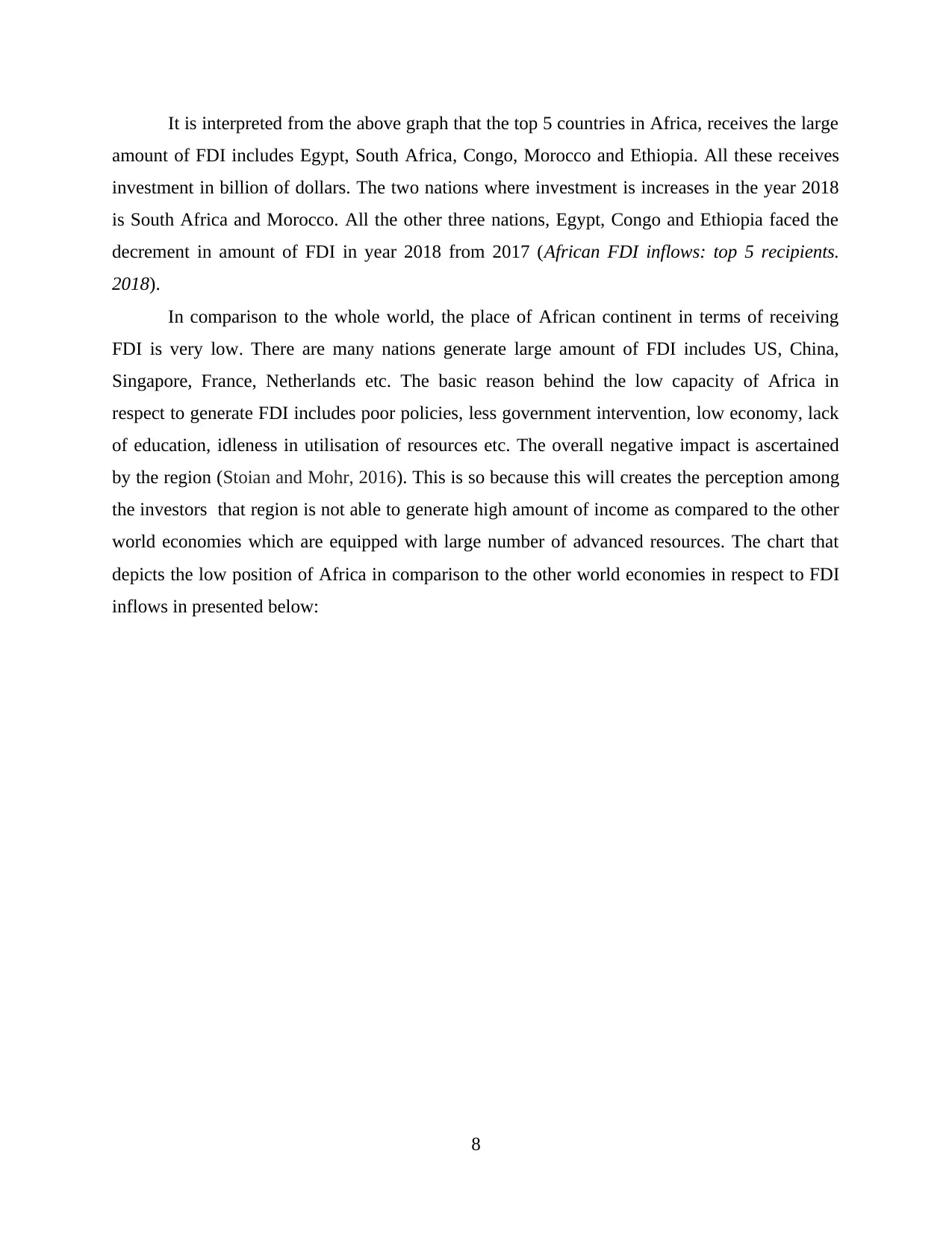
It is interpreted from the above graph that the top 5 countries in Africa, receives the large
amount of FDI includes Egypt, South Africa, Congo, Morocco and Ethiopia. All these receives
investment in billion of dollars. The two nations where investment is increases in the year 2018
is South Africa and Morocco. All the other three nations, Egypt, Congo and Ethiopia faced the
decrement in amount of FDI in year 2018 from 2017 (African FDI inflows: top 5 recipients.
2018).
In comparison to the whole world, the place of African continent in terms of receiving
FDI is very low. There are many nations generate large amount of FDI includes US, China,
Singapore, France, Netherlands etc. The basic reason behind the low capacity of Africa in
respect to generate FDI includes poor policies, less government intervention, low economy, lack
of education, idleness in utilisation of resources etc. The overall negative impact is ascertained
by the region (Stoian and Mohr, 2016). This is so because this will creates the perception among
the investors that region is not able to generate high amount of income as compared to the other
world economies which are equipped with large number of advanced resources. The chart that
depicts the low position of Africa in comparison to the other world economies in respect to FDI
inflows in presented below:
8
amount of FDI includes Egypt, South Africa, Congo, Morocco and Ethiopia. All these receives
investment in billion of dollars. The two nations where investment is increases in the year 2018
is South Africa and Morocco. All the other three nations, Egypt, Congo and Ethiopia faced the
decrement in amount of FDI in year 2018 from 2017 (African FDI inflows: top 5 recipients.
2018).
In comparison to the whole world, the place of African continent in terms of receiving
FDI is very low. There are many nations generate large amount of FDI includes US, China,
Singapore, France, Netherlands etc. The basic reason behind the low capacity of Africa in
respect to generate FDI includes poor policies, less government intervention, low economy, lack
of education, idleness in utilisation of resources etc. The overall negative impact is ascertained
by the region (Stoian and Mohr, 2016). This is so because this will creates the perception among
the investors that region is not able to generate high amount of income as compared to the other
world economies which are equipped with large number of advanced resources. The chart that
depicts the low position of Africa in comparison to the other world economies in respect to FDI
inflows in presented below:
8
Paraphrase This Document
Need a fresh take? Get an instant paraphrase of this document with our AI Paraphraser
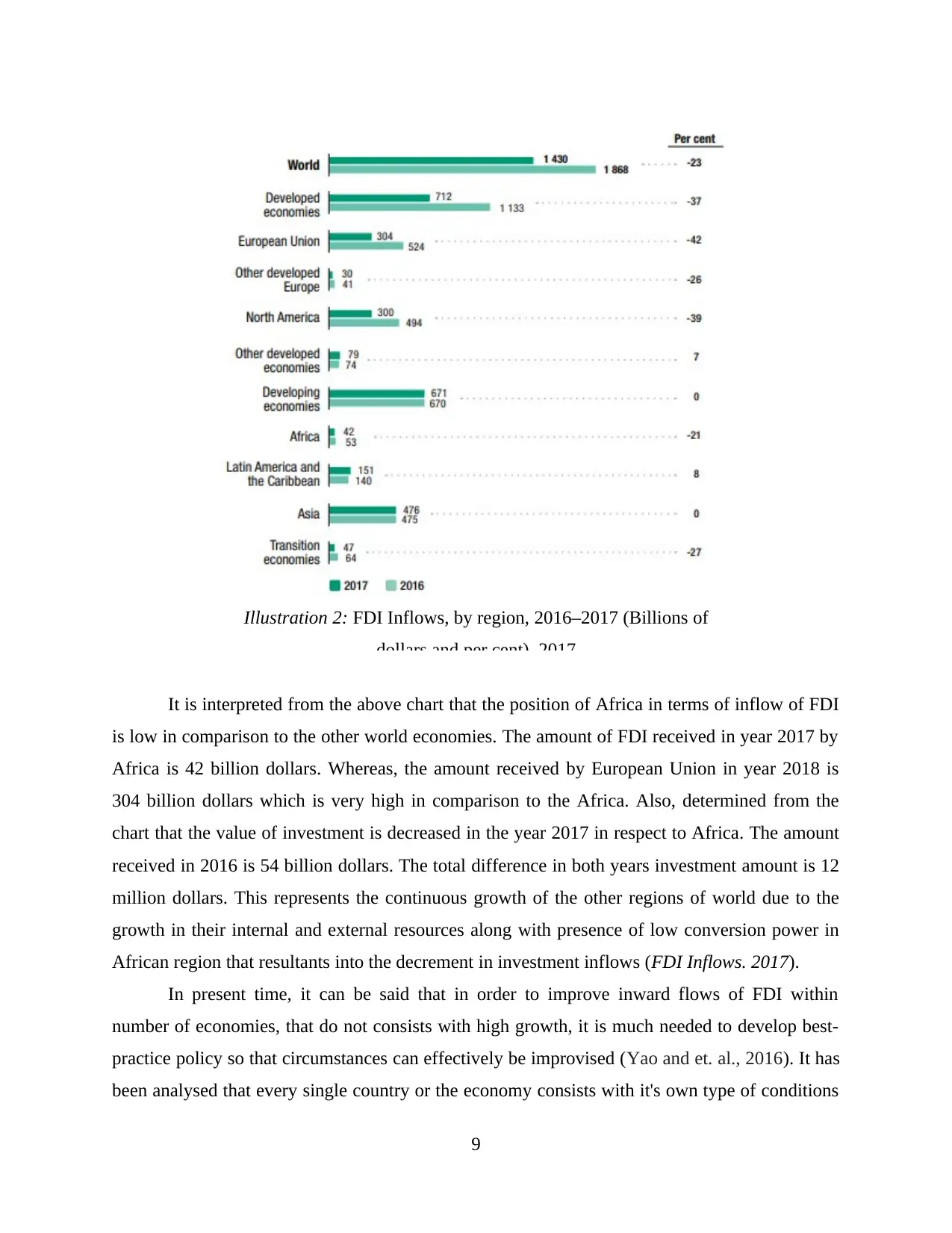
It is interpreted from the above chart that the position of Africa in terms of inflow of FDI
is low in comparison to the other world economies. The amount of FDI received in year 2017 by
Africa is 42 billion dollars. Whereas, the amount received by European Union in year 2018 is
304 billion dollars which is very high in comparison to the Africa. Also, determined from the
chart that the value of investment is decreased in the year 2017 in respect to Africa. The amount
received in 2016 is 54 billion dollars. The total difference in both years investment amount is 12
million dollars. This represents the continuous growth of the other regions of world due to the
growth in their internal and external resources along with presence of low conversion power in
African region that resultants into the decrement in investment inflows (FDI Inflows. 2017).
In present time, it can be said that in order to improve inward flows of FDI within
number of economies, that do not consists with high growth, it is much needed to develop best-
practice policy so that circumstances can effectively be improvised (Yao and et. al., 2016). It has
been analysed that every single country or the economy consists with it's own type of conditions
9
Illustration 2: FDI Inflows, by region, 2016–2017 (Billions of
dollars and per cent), 2017
is low in comparison to the other world economies. The amount of FDI received in year 2017 by
Africa is 42 billion dollars. Whereas, the amount received by European Union in year 2018 is
304 billion dollars which is very high in comparison to the Africa. Also, determined from the
chart that the value of investment is decreased in the year 2017 in respect to Africa. The amount
received in 2016 is 54 billion dollars. The total difference in both years investment amount is 12
million dollars. This represents the continuous growth of the other regions of world due to the
growth in their internal and external resources along with presence of low conversion power in
African region that resultants into the decrement in investment inflows (FDI Inflows. 2017).
In present time, it can be said that in order to improve inward flows of FDI within
number of economies, that do not consists with high growth, it is much needed to develop best-
practice policy so that circumstances can effectively be improvised (Yao and et. al., 2016). It has
been analysed that every single country or the economy consists with it's own type of conditions
9
Illustration 2: FDI Inflows, by region, 2016–2017 (Billions of
dollars and per cent), 2017
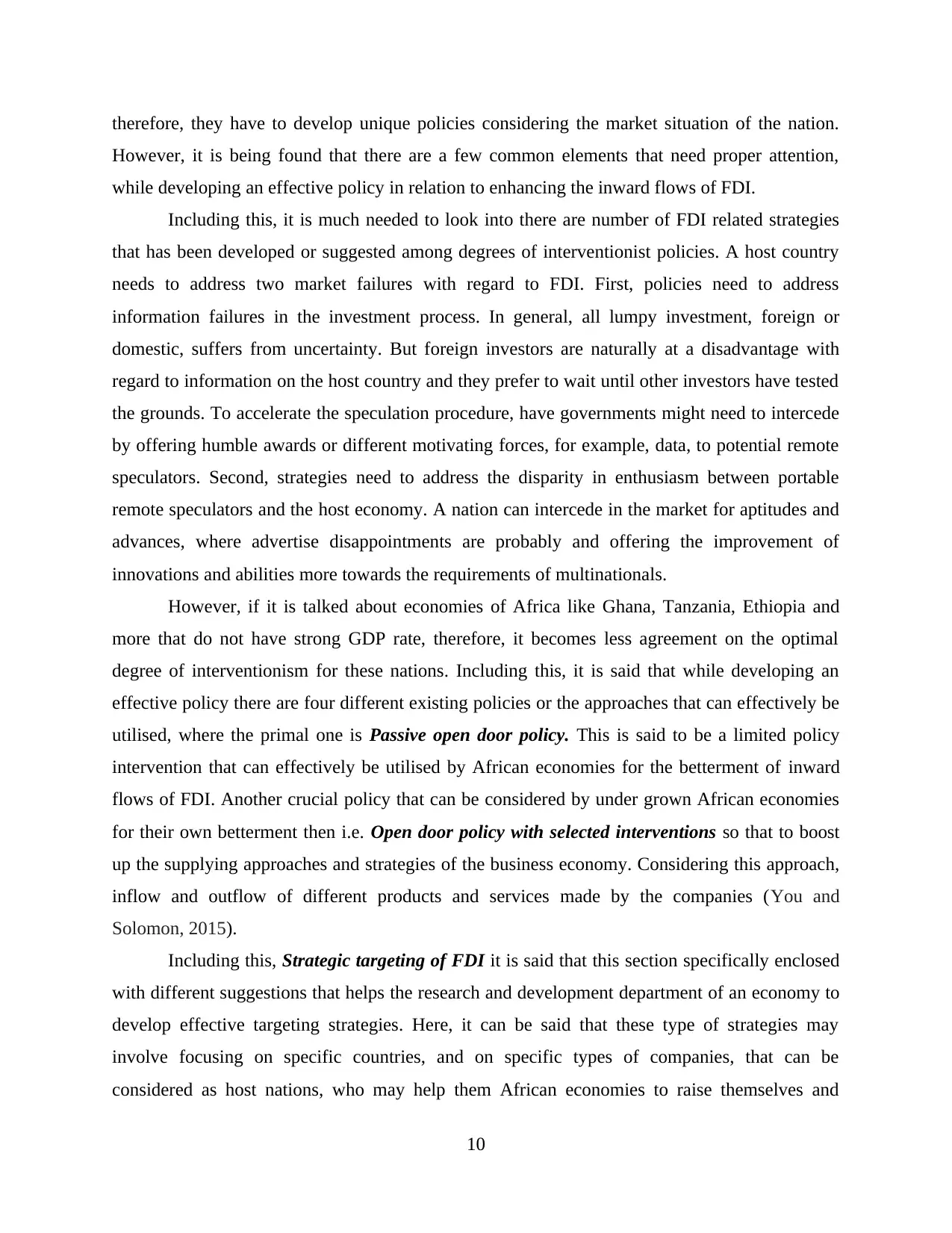
therefore, they have to develop unique policies considering the market situation of the nation.
However, it is being found that there are a few common elements that need proper attention,
while developing an effective policy in relation to enhancing the inward flows of FDI.
Including this, it is much needed to look into there are number of FDI related strategies
that has been developed or suggested among degrees of interventionist policies. A host country
needs to address two market failures with regard to FDI. First, policies need to address
information failures in the investment process. In general, all lumpy investment, foreign or
domestic, suffers from uncertainty. But foreign investors are naturally at a disadvantage with
regard to information on the host country and they prefer to wait until other investors have tested
the grounds. To accelerate the speculation procedure, have governments might need to intercede
by offering humble awards or different motivating forces, for example, data, to potential remote
speculators. Second, strategies need to address the disparity in enthusiasm between portable
remote speculators and the host economy. A nation can intercede in the market for aptitudes and
advances, where advertise disappointments are probably and offering the improvement of
innovations and abilities more towards the requirements of multinationals.
However, if it is talked about economies of Africa like Ghana, Tanzania, Ethiopia and
more that do not have strong GDP rate, therefore, it becomes less agreement on the optimal
degree of interventionism for these nations. Including this, it is said that while developing an
effective policy there are four different existing policies or the approaches that can effectively be
utilised, where the primal one is Passive open door policy. This is said to be a limited policy
intervention that can effectively be utilised by African economies for the betterment of inward
flows of FDI. Another crucial policy that can be considered by under grown African economies
for their own betterment then i.e. Open door policy with selected interventions so that to boost
up the supplying approaches and strategies of the business economy. Considering this approach,
inflow and outflow of different products and services made by the companies (You and
Solomon, 2015).
Including this, Strategic targeting of FDI it is said that this section specifically enclosed
with different suggestions that helps the research and development department of an economy to
develop effective targeting strategies. Here, it can be said that these type of strategies may
involve focusing on specific countries, and on specific types of companies, that can be
considered as host nations, who may help them African economies to raise themselves and
10
However, it is being found that there are a few common elements that need proper attention,
while developing an effective policy in relation to enhancing the inward flows of FDI.
Including this, it is much needed to look into there are number of FDI related strategies
that has been developed or suggested among degrees of interventionist policies. A host country
needs to address two market failures with regard to FDI. First, policies need to address
information failures in the investment process. In general, all lumpy investment, foreign or
domestic, suffers from uncertainty. But foreign investors are naturally at a disadvantage with
regard to information on the host country and they prefer to wait until other investors have tested
the grounds. To accelerate the speculation procedure, have governments might need to intercede
by offering humble awards or different motivating forces, for example, data, to potential remote
speculators. Second, strategies need to address the disparity in enthusiasm between portable
remote speculators and the host economy. A nation can intercede in the market for aptitudes and
advances, where advertise disappointments are probably and offering the improvement of
innovations and abilities more towards the requirements of multinationals.
However, if it is talked about economies of Africa like Ghana, Tanzania, Ethiopia and
more that do not have strong GDP rate, therefore, it becomes less agreement on the optimal
degree of interventionism for these nations. Including this, it is said that while developing an
effective policy there are four different existing policies or the approaches that can effectively be
utilised, where the primal one is Passive open door policy. This is said to be a limited policy
intervention that can effectively be utilised by African economies for the betterment of inward
flows of FDI. Another crucial policy that can be considered by under grown African economies
for their own betterment then i.e. Open door policy with selected interventions so that to boost
up the supplying approaches and strategies of the business economy. Considering this approach,
inflow and outflow of different products and services made by the companies (You and
Solomon, 2015).
Including this, Strategic targeting of FDI it is said that this section specifically enclosed
with different suggestions that helps the research and development department of an economy to
develop effective targeting strategies. Here, it can be said that these type of strategies may
involve focusing on specific countries, and on specific types of companies, that can be
considered as host nations, who may help them African economies to raise themselves and
10
⊘ This is a preview!⊘
Do you want full access?
Subscribe today to unlock all pages.

Trusted by 1+ million students worldwide
1 out of 15
Related Documents
Your All-in-One AI-Powered Toolkit for Academic Success.
+13062052269
info@desklib.com
Available 24*7 on WhatsApp / Email
![[object Object]](/_next/static/media/star-bottom.7253800d.svg)
Unlock your academic potential
Copyright © 2020–2025 A2Z Services. All Rights Reserved. Developed and managed by ZUCOL.





